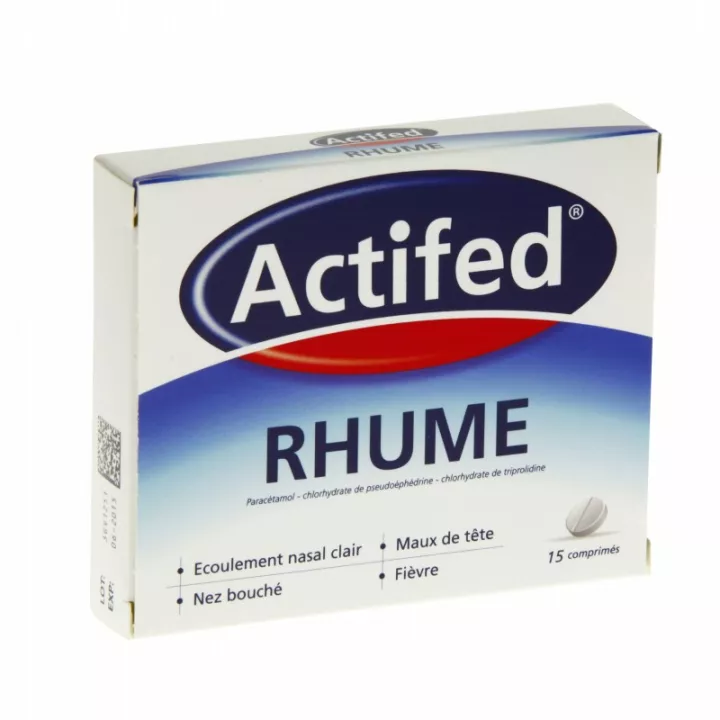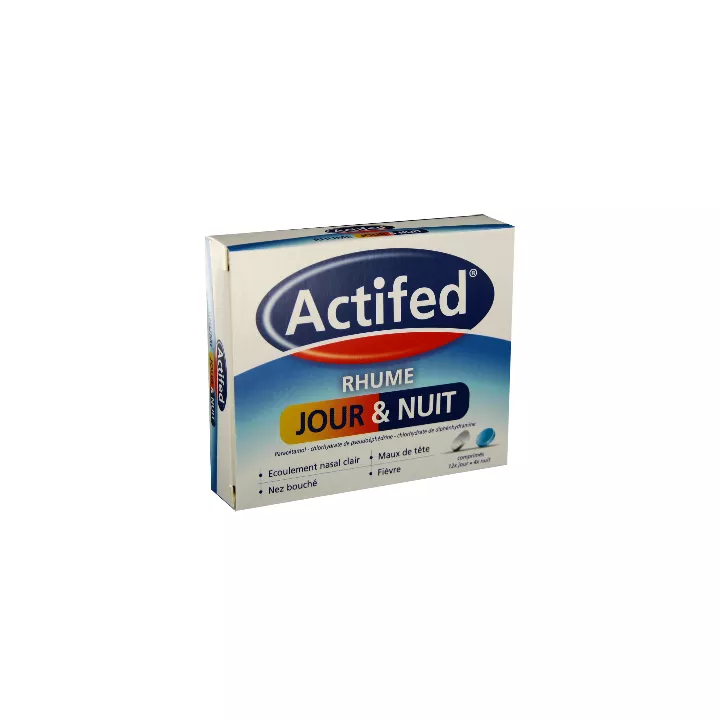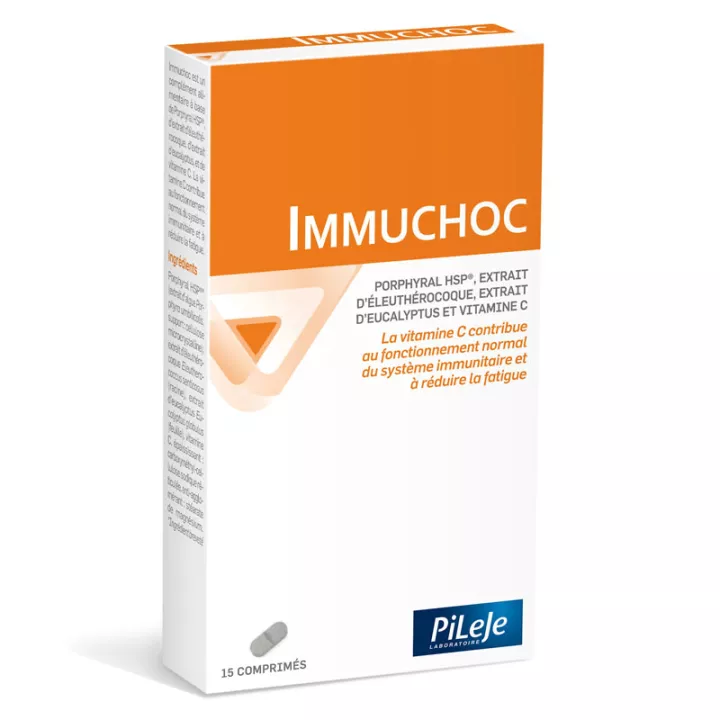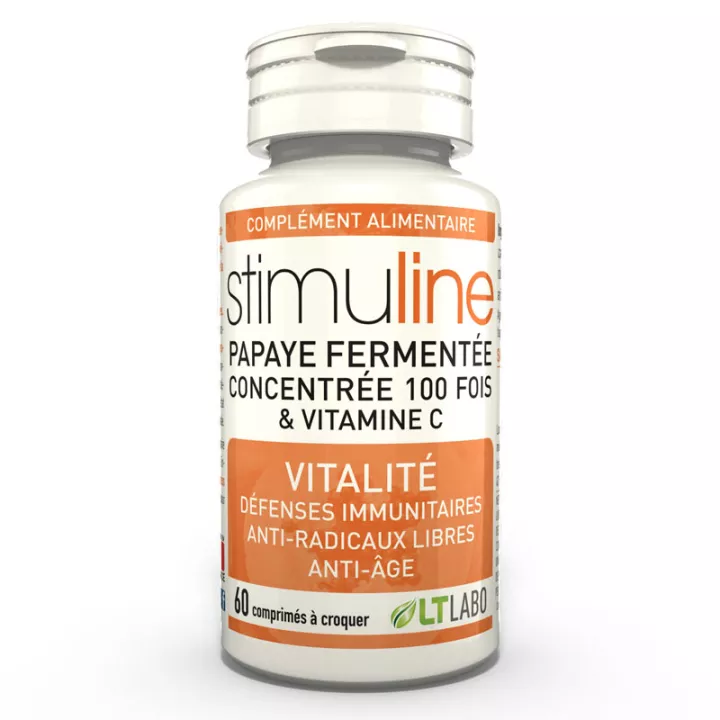NOTICE
ANSM - Last updated: 06/06/2011
Description of the Medicine
ACTIFED RHUME, tablet
Paracetamol / Pseudoephedrine hydrochloride / Triprolidine hydrochloride
© framed
Read this leaflet carefully before taking this medication. It contains important information for your treatment.
AT· This medication can be used in self-treatment, ie without consultation or prescription of a doctor.
AT· If the symptoms persist, if they become worse or if new symptoms appear, seek the advice of your pharmacist or your doctor.
AT· This leaflet is designed to help you use this medication. Keep it, you might need to reread it.
DO NOT LEAVE THIS MEDICINE FOR CHILDREN.
Review summary
In this notice :
1. WHAT IS ACTIFED RHEUME, tablet and WHAT IT IS USED FOR?
2. BEFORE YOU TAKE ACTIFED RHEUME, COMPRESSED?
3. HOW TO TAKE ACTIFED RHEUME, tablet?
4. WHAT ARE POSSIBLE SIDE EFFECTS?
5. HOW TO STORE ACTIFED RHUME, tablet?
6. ADDITIONAL INFORMATION
1. WHAT IS ACTIFED RHEUME, tablet and WHAT IT IS USED FOR?
Pharmacotherapeutic group
This drug combines three active ingredients: an analgesic (paracetamol), a nasal discomforting vasoconstrictor (pseudoephedrine), an antihistamine (triprolidine).
DECONGESENTANTS FOR SYSTEMIC USE.
Therapeutic Indications
This medication is indicated in the treatment during the colds of the adult and the adolescent of more than 15 years:
AT· stuffy nose sensations,
AT· clear nasal discharge,
AT· headache and / or fever.
2. BEFORE YOU TAKE ACTIFED RHEUME, COMPRESSED?
List of information needed before taking the medication
Not applicable.
Cons-indications
Never take ACTIFED RHUME tablets in the following cases:
AT· In case of a history of allergy to the constituents of the product.
AT· Child under 15 years old.
AT· If you have a brain stroke.
AT· In case of severe or poorly balanced arterial hypertension by the treatment.
AT· In case of serious heart disease (coronary insufficiency).
AT· If you have some forms of glaucoma (increased pressure in the eye).
AT· In case of difficulty urinating from prostatic or other origin.
AT· In case of convulsions old or recent.
AT· In case of severe liver or kidney disease due to the presence of paracetamol.
AT· If you are breastfeeding.
AT· In combination with non-selective MAOIs due to the risk of paroxysmal hypertension and potentially fatal hyperthermia.
AT· In combination with other sympathomimetics with indirect action: vasoconstrictors intended to disrupt the nose, whether administered orally or nasally [phenylenine (alias neo-nucleosine), pseudo Phenine, Phenrin and Phenylphenidate, due to the risk of vasoconstriction and / or hypertension.
AT· In combination with alpha sympathomimetics: vasoconstrictors intended to disrupt the nose, whether administered orally or nasally (eg, spine, midodrine, naphazoline, oxymethazoline, nylestrine (alias neonynynthine), synthetin, tetazoline, tuaminoheptane, tymazoline], because of the risk of vasoconstriction and / or hypertensive surges.
The combination of two disorientants is contraindicated, regardless of the route of administration (oral and / or nasal): such an association is unnecessary and dangerous and corresponds to a mishap. |
You should not use this medication unless your doctor tells you otherwise during pregnancy.
IN CASE OF DOUBT, IT IS ESSENTIAL TO ASK FOR THE OPINION OF YOUR DOCTOR OR YOUR PHARMACIST.
Employment Precautions; special warnings
Take special care with ACTIFED RHUME, tablet:
Special warnings
DO NOT LEAVE THIS MEDICINE FOR CHILDREN.
AT· It is imperative to strictly observe the dosage, the duration of treatment of 5 days, and the contraindications.
AT· In case of overdose or mistake of a dose too high, consult your doctor immediately.
This medicine contains paracetamol. Other medicines contain it. Do not combine them, so as not to exceed the recommended daily dose ( see section on dosage ). |
AT· During treatment, if there is a feeling of acceleration of the heartbeat, palpitations, onset or increase of headache, nausea, behavioral disturbances, arrest the treatment and contact your doctor immediately.
PREVENT YOUR DOCTOR, if you suffer:
AT· of arterial hypertension,
AT· heart disease, hyperthyroidism (hyperfunction of the thyroid gland),
AT· personality disorders,
AT· of diabetes.
PREVENT YOUR DOCTOR, if you take:
AT· a selective MAO-A (moclobemide, toloxatone),
AT· a treatment containing an alkaloid of rye ergot:
o dopaminergic, such as bromocriptine, cabergoline, lisuride or pergolide,
(for example an antiparkinsonian)
o vasoconstrictor, such as dihydroergotamine, ergotamine, methyleneergomethrin, methysergide),
(for example an antimigraine)
AT· of linoleol.
Employment Precautions
AT· In case of purulent nasal discharge, persistence of fever, absence of improvement after 5 days of treatment, CONSULT YOUR DOCTOR.
AT· In case of severe liver or kidney disease, it is necessary to consult your doctor before taking this medication (due to the presence of paracetamol).
AT· In the elderly or subjects predisposed to constipation, dizziness and urinary disorders.
AT· This medication may lead to drowsiness caused by alcohol: it is preferable to start treatment at night and to refrain from alcoholic beverages or medicines containing alcohol, alcohol during the course of treatment.
IN CASE OF DOUBT, DO NOT HESITATE TO ASK FOR THE OPINION OF YOUR DOCTOR OR YOUR PHARMACIST.
Interactions with other medicines
Taking or using other medicines:
If you are taking or have recently taken any other medicines, including medicines obtained without a prescription, speak to your doctor or pharmacist.
This medication contains a vasoconstrictor, pseudoephedrine.
This medication should not be administered in combination with:
AT· other vasoconstrictors whether administered orally or nasally (phenyl-erythritol (alias neo-synnephrine), pseudoephedrine, ephedrine, methylphenidate, Tetrazole, midodrine, naphazoline, oxymethazoline, synthetine, tetazoline, tuaminoheptane, tymazoline);
AT· a non-selective MAO-A (iproniazide).
It is advisable to use this medication if you are already treated:
AT· by a selective MAO-A medication, prescribed medication in some depressive states;
AT· and / or by other dopaminergic or vasoconstrictor medicines such as bromocriptine, cabergoline, lisuride, pergolide or dihydroergotamine, ergotamine, methyleneergomethrin, methysergide, prescribed medications to treat certain neurological or endocrine disorders or migraines;
AT· by linoleol.
Taking alcoholic or alcohol-containing medications should be avoided for the duration of treatment.
Tell your doctor if you are taking this medication if your doctor prescribes a dosage of uric acid or blood sugar.
In order to avoid the detrimental effects of an overdose, DO NOT ASSOCIATE WITHOUT MEDICAL ADVICE of other medicines containing vasoconstrictors, paracetamol or antihistamines. IN CASE OF DOUBT, DO NOT HESITATE TO ASK FOR THE OPINION OF YOUR DOCTOR OR YOUR PHARMACIST. |
Interactions with food and beverages
Not applicable.
Interactions with phytotherapeutic products or alternative therapies
Not applicable.
Use during pregnancy and lactation
Pregnancy and breast feeding
Ask your doctor or pharmacist for advice before taking any medication. |
Pregnancy
The use of this medication is generally discouraged during pregnancy.
feeding
Due to possible harmful effects in the infant, taking this medication is contraindicated if you are breast-feeding.
Sport
Sport
Warning: this specialty contains an active ingredient (pseudoephedrine) which can induce a positive reaction of the tests performed during the anti-doping tests.
Effects on ability to drive or use machines
Driving and using machines:
Attention is drawn to the risks of drowsiness or decreased vigilance associated with the use of this medication, particularly among drivers of vehicles and machine users.
This phenomenon is accentuated by the intake of alcoholic beverages or medications containing alcohol.
List of excipients with known effect
Not applicable.
3. HOW TO TAKE ACTIFED RHEUME, tablet?
Instructions for proper use
Not applicable.
Dosage, Mode and / or Route (s) of Administration, Administration Frequency and Duration of Treatment
Dosage
RESERVED FOR ADULTS AND ADOLESCENTS OVER 15 YEARS.
1 tablet to be renewed if necessary after 6 hours, without exceeding 3 tablets per day.
IN CASE OF DOUBT, ASK FOR ADVICE TO YOUR DOCTOR OR YOUR PHARMACIST.
Method and route of administration
Oral use.
The tablet is to be swallowed as is with a drink (eg water, milk, fruit juice).
Frequency of administration
To be renewed if necessary after 4 hours minimum.
In case of severe kidney disease (severe renal insufficiency), space the catch for at least 8 hours.
Duration of treatment
The duration of use is limited to 5 days. If there is no improvement as in the case of symptoms persisting beyond 5 days of treatment, take a medical opinion.
If the symptoms do not go away, do not continue treatment and seek the advice of your doctor.
Symptoms and Instructions for Overdose
If you take more ACTIFED RHEUME, you should have:
In case of accidental overdose or intoxication, STOP TREATMENT AND IMMEDIATELY CONSULT YOUR DOCTOR.
Instructions for omission of one or more doses
If you forget to take ACTIFED RHEUME, tablet:
Do not take a double dose to make up for the missed dose.
Risk of withdrawal syndrome
Not applicable.
4. WHAT ARE POSSIBLE SIDE EFFECTS?
Description of undesirable effects
Like all medicines, ACTIFED RHEUME, tablet is likely to have undesirable effects, although not everyone is subject to it.
Due to the presence of pseudoephedrine, this medication may cause:
AT· General effects such as:
o headaches, vascular accidents,
o palpitations, high arterial hypertension, myocardial infarction, sweating, behavioral disturbances, nausea, vomiting,
o the onset of an acute glaucoma crisis in pre-disposed subjects that can result in a red and painful eye,
IN THESE CASES, STOP THE TREATMENT AND CONTACT YOUR DOCTOR IMMEDIATELY.
AT· May also occur:
o allergic reactions,
o urinary disorders (significant decrease in urine, difficulty urinating),
o a dryness of the mouth,
o convulsions, hallucinations, restlessness, behavioral disorders and insomnia, have been described in particular in children,
o disorders of memory or concentration, confusion, dizziness (more frequent in the elderly),
o a motor incoordination, tremors,
o drowsiness, decreased alertness, more marked early treatment,
o of allergic reactions:
AT§ of skin type (redness, rash, urticaria, eczema),
AT§ Angioedema (abrupt swelling of the face and neck can lead to respiratory discomfort),
AT§ anaphylactic shock (severe and very severe allergic reaction),
o fall of the arterial pressure during the passage to the standing position which may be accompanied by vertigo,
o exceptionally haemorrhagic strokes have been reported in patients treated with medicinal products containing a vasoconstrictor, in particular in the case of overdosage, non-compliance with contraindications or warnings, or in patients with vascular risk factors ( see 2. BEFORE YOU TAKE ACTIFED RHEUME, tablet, sub-sections: "Do not take ACTIFED RHEUME, tablet the following situations " , " Take special care with ACTIFED RHEUME, tablet " ).
IN THESE CASES, STOP THE TREATMENT AND CONTACT YOUR DOCTOR IMMEDIATELY.
Due to the presence of paracetamol:
AT· In rare cases, it is possible that a rash or redness of the skin or an allergic reaction may occur, which can be manifested by a sudden swelling of the face and neck or by a sudden discomfort with fall of the aroused pressure rial. Immediately stop treatment, notify your doctor and never take any medicines containing paracetamol.
AT· Exceptionally, biological changes requiring blood check were observed: abnormally low blood levels of certain blood components (platelets) which may result in nosebleeds or gums. In this case, consult a physician.
If you notice any side effects not listed in this leaflet, or if certain undesirable effects become serious, please inform your doctor or pharmacist.
5. HOW TO STORE ACTIFED RHUME, tablet?
Keep out of the reach and sight of children.
Date of filing
Do not use ACTIFED RHUME, tablet after the expiration date stated on the carton. The expiry date refers to the last day of the month.
Storage conditions
Keep at a temperature not exceeding 25 ° C.
If necessary, warnings against some visible signs of deterioration
Medicines should not be thrown away or washed away with household garbage. Ask your pharmacist what to do with unused medications. These measures will protect the environment.
6. ADDITIONAL INFORMATION
Full list of active substances and excipients
What does ACTIFED RHEUME contain, tablet?
The active substances are:
Paracetamol ............................................... .................................................. ............................... 500.00 mg
Pseudoephedrine hydrochloride ........................................... .................................................. ...... 60.00 mg
Triprolidine hydrochloride ............................................... .................................................. ............ 25.00 mg
For one tablet.
The other components are:
Pre-latinized maize starch, povidone, crospovidone, styrene acid, microcrystalline cellulose, colloidal silica, magnesium stearate.
Pharmaceutical form and content
What is ACTIFED RHEUME, tablet and contents of the outer packaging?
This medication is in the form of a tablet. Box of 15 tablets.
Name and address of the marketing authorization holder and the holder of the manufacturing authorization responsible for the release of the lots, if different
Holder
JOHNSON & JOHNSON SANTE BEAUTE FRANCE
1 RUE CAMILLE DESMOULINS
92130 ISSY LES MOULINEAUX
exploiting
JOHNSON & JOHNSON SANTE BEAUTE FRANCE
1 RUE CAMILLE DESMOULINS
92130 ISSY LES MOULINEAUX
Maker
JANSSEN CILAG SA
DOMAIN OF MAIGREMONT
27100 VAL DE REUIL
Names of medicines in the Member States of the European Economic Area
Not applicable.
Date of approval of the notice
The last day this notice was approved is {date}.
AMM under exceptional circumstances
Not applicable.
Internet Information
Detailed information on this medicinal product can be found on the website of the Afssaps (France).
Information for Health Professionals
Not applicable.
Other
ADVICE / HEALTH EDUCATION
"WHAT TO DO IN CASE OF A NOSE MOUTH OR NOSE THAT CASTING":
This medication is used in the treatment of the sensation of clogged nose and / or headaches during colds in adults and adolescents over 15 years of age.
The common cold is a very acute benign infection that affects the nasal mucosa (inner lining of the nose). This mucous membrane creates a liquid whose role is to constantly moisten the inspired air and fight against infectious agents. When this mucosa is irritated, it swells and increases its usual liquid seizure, so that the nose "gets clogged" or that the nose "sinks".
In order to limit the occurrence of symptoms, respect as much as possible the following hygiene rules:
AT· wash hands regularly, especially before meals or when preparing them;
AT· cover your mouth when coughing or sneezing;
AT· blow your nose often with disposable handkerchiefs (not to recontaminate) and throw them in a trash immediately after use, then wash your hands;
AT· Avoid visiting a young child and her newborn, an elderly person, or a person treated with immunosuppressants (corticosteroids, medicines for a disease of the blood or a cancer ...). In these cases, wearing the mask is recommended.
For your comfort:
AT· drink enough;
AT· moisten the nasal mucosa with suitable washing solutions (physiological serum, sprays of thermal water or sea water);
AT· Avoid smoking or breathing the smoke of others;
AT· sleeping the raised head to improve the airflow in the clogged nostrils and to sleep sufficiently;
AT· protect the skin of the upper lip and the nostrils by a cream as the repetition of the flies tends to irritate the skin;
AT· Avoid air conditioners that dehumidify the air and dry the nasal mucous membranes, the ideal temperature of the room should be around 18-20 ° C;
AT· regularly aerate the parts.
"WHAT TO DO IN THE EVENT OF FEVER":
Normal body temperature varies from person to person and ranges from 36.5 ° C to 37.5 ° C.
A rise of more than 0.8 ° C is considered a fever.
In adults and adolescents over 15 years of age: if the disorders they cause are too troublesome, you can take a medication that contains paracetamol in accordance with the indicated dosages.
With this medication, the fever should drop rapidly. NÃ © Nevertheless:
AT· if other signs appear (such as cutaneous eruption),
AT· if the fever persists for more than 3 days or if it worsens,
AT· if the headache becomes violent, or in case of vomiting,
CONSULT YOUR DOCTOR IMMEDIATELY.







